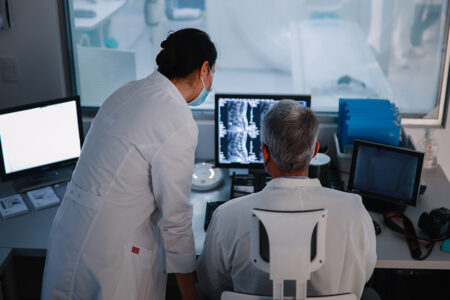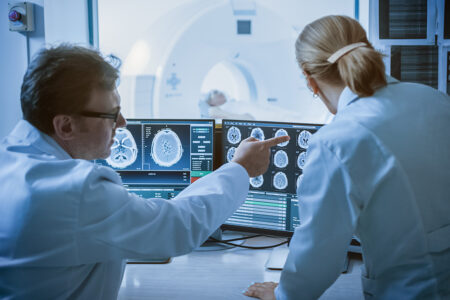Abstract: Feasibility and accuracy of a hands-free robotic system for CT-guided needle insertion in percutaneous lung biopsies
Abstract: Feasibility and accuracy of a hands-free robotic system for CT-guided needle insertion in percutaneous lung biopsies
Presented at Society of Interventional Oncology Annual Scientific Meeting, 2022
Authors: Brandon Kelly MD, Sebastian Flacke MD PhD, Department of Radiology, Lahey Hospital and Medical Center, Tufts University Medical School, Burlington, MA, US; Gerald Grubbs MD, Sarasota Interventional Radiology, Sarasota, Fl, US; Moran Shochat, Danielle Bradbury, Mark Macedo, Chelsea Belligan APRN, Xact Robotics, Ceasarea, Israel
Purpose
To assess feasibility and accuracy of CT-guided needle insertion for clinical biopsies using a novel, hands-free robotic system.
Materials and methods
A prospective, multi-center pilot study was conducted upon 20 clinically indicated biopsies of lung lesions at two centers (Center 1 n=14; Center 2 n=6). CT datasets were obtained for planning and controlled needle placement of 19g needles using a patient-mounted, CT-guided robotic system with 5° freedom. Planning included target selection, skin entry point, and predetermined checkpoints where additional imaging was performed to permit stepwise correction of needle trajectory. Success rate, needle tip to target distance, number of checkpoints used, number of trajectory corrections, procedure duration, effective radiation dose and adverse events were recorded. Data were compared between sites. Significance level was set to p<0.05.
Results
Study population consisted of 10 men and 10 women, average age 73.4 ± 6.5 years. Fourteen procedures were performed in the prone position, 5 in supine and 1 in decubitus position. Lesions were distributed throughout each lobe of the lung. Nine lesions were in contact with the pleura. Skin to lesion distance was less than 8 cm in 14 patients and greater than 8 cm in the remaining 6 patients. Six lesions were smaller than 1 cm, 14 were larger than 1 cm.
In 17 of 20 procedures (85%) the robot positioned the trocar needle successfully on target. Overall accuracy (needle tip to target distance) was 1.44±0.71 (0.5-3) mm. Average dose length product for the successfully completed procedures was 2042 ± 960 mGycm.
In 2 of the remaining patients the procedure was manually performed by the operator. In these patients a rib obstructed the planned trajectory after insertion of the needle secondary to changes in respiratory depth, requiring reinsertion of the needle. One patient developed a progressive pneumothorax with respiratory failure during manual needle advancement, which required immediate chest tube insertion and abortion of the biopsy.
Four out of the 17 patients (23%) in whom the robot positioned the trocar needle successfully developed a pneumothorax which was managed until complete resolution with observation (n=1) or chest tube placement and observation (n=3).
Conclusion
Accurate needle targeting of lung lesions within 2mm error with a single pleural puncture can be achieved in patients when using a CT-guided robotic system.





